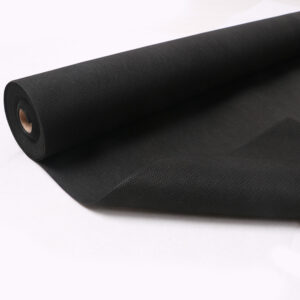Geotextiles
Geotextiles form one of the largest groups of geosynthetics. These are woven, non woven or knitted textiles consisting of natural or synthetic fibers. These are flexible and permeable in nature. Geotextiles are generically made from plastic materials, mostly polypropylene and polyester, but also polyethylene, polyamide (nylon), polyvinylidene chloride, and fibreglass (e.g., in roadway substrates) are used. Sewing thread for geotextiles is generally made from any of the above polymers.
Nonwoven Geotextiles
Nonwoven fabric is a fabric-like material made from staple fibre (short) and long fibres (continuous long), bonded together by chemical, mechanical, heat or solvent treatment. Nonwoven fabrics are broadly defined as sheet or web structures bonded together by entangling fiber or filaments (and by perforating films) mechanically, thermally or chemically. They are flat or tufted porous sheets that are made directly from separate fibres, molten plastic or plastic film.
Nonwoven fabrics are engineered fabrics that may be single-use, have a limited life, or be very durable. Nonwoven fabrics provide specific functions such as absorbency, liquid repellence, resilience, stretch, softness, strength, flame retardancy, washability, cushioning, thermal insulation, acoustic insulation, filtration, use as a bacterial barrier and sterility. Non-woven materials are used in numerous applications, apparel, home furnishings, health care, engineering, industrial and consumer goods.

- Mass per square metre [ASTM D: 5261 / ISO: 9864]
- Wide Width Tensile Strength Machine Direction & Cross Direction [ASTM D: 4595 / EN ISO: 10319]
- Grab Breaking Load Machine Direction & Cross Direction [ASTM D: 4632]
- Thickness [ASTM D: 5199]
- Ball Bursting Strength [ASTM D:3787]
- Diaphragm Bursting Strength [ASTM D: 3786]
- Index Puncture Resistance [ASTM D: 4833]
- Trapezoid Tear Strength [ASTM D: 4533]
- Cone Drop Test (Dynamic Puncture Test) [EN: 918 / ISO: 13433]
- Static Puncture Strength (CBR Puncture Strength) [ASTM D: 6241 / BS EN ISO: 12236]
- Apparent Opening Size [ASTM D: 4751]
- Pore Size by Porometer [ASTM D: 6767]
- Water Permeability of Filter [ASTM D: 4491 / BS: 6906 / ISO: 11058]
- Seam Strength [ASTM D: 4884 / ISO: 10321]
- Abrasion Resistance [ASTM D: 4886]
- Tensile Strength (Before & After by ASTM D: 5035)]
- Pull out resistance in soil [ASTM D:6706 / DIN EN 13738]
- Chemical resistance (acid & alkali) [DIN EN 14030]
- Deterioration from outdoor exposure [ASTM D:5970]
- UV Resistance by Xenon arc lamp [ASTM D:4355]
- Hydraulic transmissivity using a constant head [ASTM D:4716]
- Resistance to oxidation [ISO 13438]

